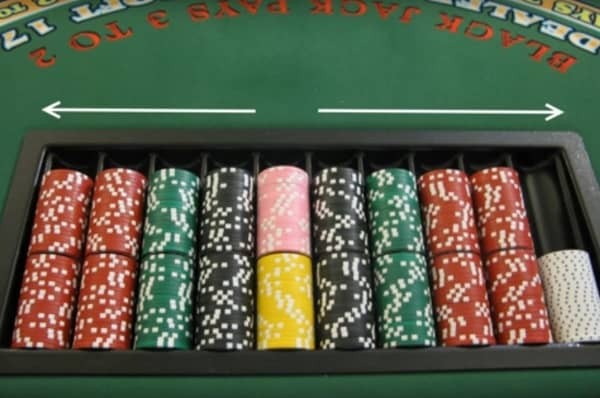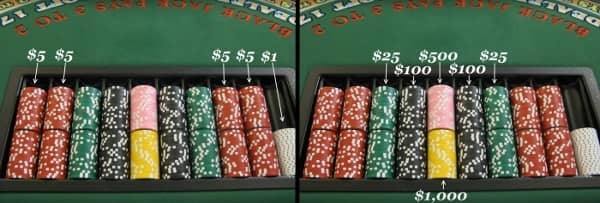Take & Pay Procedure
How to Deal Blackjack: Part 6
Table of Contents
- Taking and Paying Bets
- If the Player Loses
- If the Player Wins
- Color for Color
- Converting Cheques
- Dirty Money
- The Rack
- The Cards
- Discard Rack
How to Deal BlackjackFurther Reading
- Part 1: Introduction
- Part 2: How to Shuffle Blackjack Cards (Dealer Techniques and Procedures in 2025)
- Part 3: How to Cut, Wash, and Burn Cards in Blackjack (Dealer Procedures in 2025)
- Part 4: Delivering Cards, Pitching, Tucking Hole Cards, Checking Ace & 10
- Part 5: Handling Cheques, Playing the Game
- Part 6: Take & Pay Procedure
- Part 7: Player’s Actions & Blackjack
- Part 8: Color Up, Dead Game, & Other Procedures
- Part 9: Dealer’s Break, Tokes, Customer Service & Other Policies
- Part 10: Game Security
Did this free course help you?
Click to leave a tip to help keep this resource free!
Taking and Paying Bets
The “Take & Pay Procedure” will be performed many times per shift whenever a dealer wins or loses. Always make sure to start at the bet furthest to the right and go to the left; compare the player’s cards to your cards, one at a time, before moving on to the next hand. Always relook at the players cards and mentally double-check to make sure that you counted right.
If the Player Loses
Take the money first, as many cheques as you can hold, then put them in your rack. After all of the bets have been gone through, pick up the cards. Sort the cheques out after you have put the cards in the discard rack. Never sort through the cheques on the table.
If the Player Wins
Pay the bet first. There are 2 different ways of paying the bet. The simplest way is called “Color for Color” or you can “Convert”. Pay all bets in the circle; payoffs must touch all winning wagers. Double downs and splits may be paid outside the circle for clarity. After all of the bets have been gone through, pick up the cards.
Color for Color
This term means you pay a uniform stack of cheques, with the same color and same amount of cheques. Never touch or mess with the players cheques if you are paying “Color for Color”. There are times when paying “Color for Color” is inappropriate. One of those times is when the player already has a large stack or multiple stacks of the same color. This is a time where you want to “Convert”. If you have a choice of “Color for Color” or “Conversions” then you want to go with “Color for Color”. This is the preferred choice for break-in dealers.
Never throw or slide the cheques at the player. Never leave part of a payoff with a player, if an incorrect amount is paid, bring the entire payoff back to the tray and then come back with the correct amount. When making payoffs; do not pass cheques from one hand to the other. All payoffs must be made on the side of the bet. Never pay behind the bet and never pay on top of the cards. Only touch the players bet to straighten the stack out before you start dealing, read a bet that is over 5 cheques, or break down a multi-color bet.
Converting Cheques
This is a term used when a player has multiple cheques of the same color and the dealer wants to pay that bet with a larger denomination. Make sure you are comfortable before you try conversions, and convert only when necessary. It’s not a good idea to try this if you’re not comfortable with it. For example, if you give the player $50 but forget to take back $10, you would be giving him a larger payoff which makes it look like your cheating, and you could get you fired.
Do not convert a player into $500 denominations or above without the consent of the floor. When is it appropriate to convert? When the dealers rack is very low on one denomination and you are waiting for a fill; when the player is betting more than 5 cheques of one color; and when the player has a large amount of one color cheques.
Dirty Money
This a term used for cheques that have previously been in play and have lost. Never pay a bet with dirty money. Instead, put the dirty money in a tube in your rack and then pay with “clean money” which is cheques taken out of the rack that hasn’t been used in this hand. This helps too if there is ever a problem with a bet. The floormen knows what direction you pick up the money and since the highest amount is on bottom a floormen knows which bet is who’s without having to call the cameras.
The Rack
Working Out of the Rack

Always use the tube of color that is furthest from the center.
If you use your right hand to pay the right side of the table then use the right side of the rack, the same goes with left hand. Start with the outside tubes and work your way in. You can move cheques around to make it look cleaner.
Reading the Rack

Each tube holds one type of denominations. Notice how the smaller denominations are on the outside and the larger denominations are in the middle where the dealer is able to protect them better. Never store your cheques in an assorted order, always reorganize the rack so it is proper. Put a separator in between each stack of 20 cheques of the same color, making the rack easier to read.
The Cards
Picking Up the Cards in Order
How you pick up the cards is important. There will be times when a player will argue a hand and you will have to call over the Floor to run back the cards. In order for him to do his job correctly you had to do your job and pick the cards up in the precise order. A dealer will never run back the cards on their own.
Start the procedure by picking up the dealers cards first so they are on the top of the stack; that way when the dealer’s cards are run back the dealer’s cards are the first ones out. At some casinos they will want the dealer’s cards to be on the bottom of the stack or the last cards out so make sure you know your houses rules. Then, starting at the furthest hand to the right, pick up the cards right to left using your thumb and forefinger to catch them as you slide in the direction of the cards. Hold the cards angled so that the bottom left corner of the card sweeps underneath the next card, moving diagonally. Place the cards in the discard rack.
Picking Up the Cards on a Handheld Deck

Because the cards will be face down on a handheld deck you need to know the procedure for picking them up. Start with the player on your right and then go left. Grab the tops of the cards and flip them from top to bottom. Do not roll the cards over with the deck hand. Lay the cards in front of their bets in the correct fashion and then complete the “Take & Pay Procedure” before going on to the next hand.
Discard Rack
When the shoe is finished take the remaining cards out and turn the un-dealt portion of the deck 180 degrees and place it in a random spot in the discard rack.
